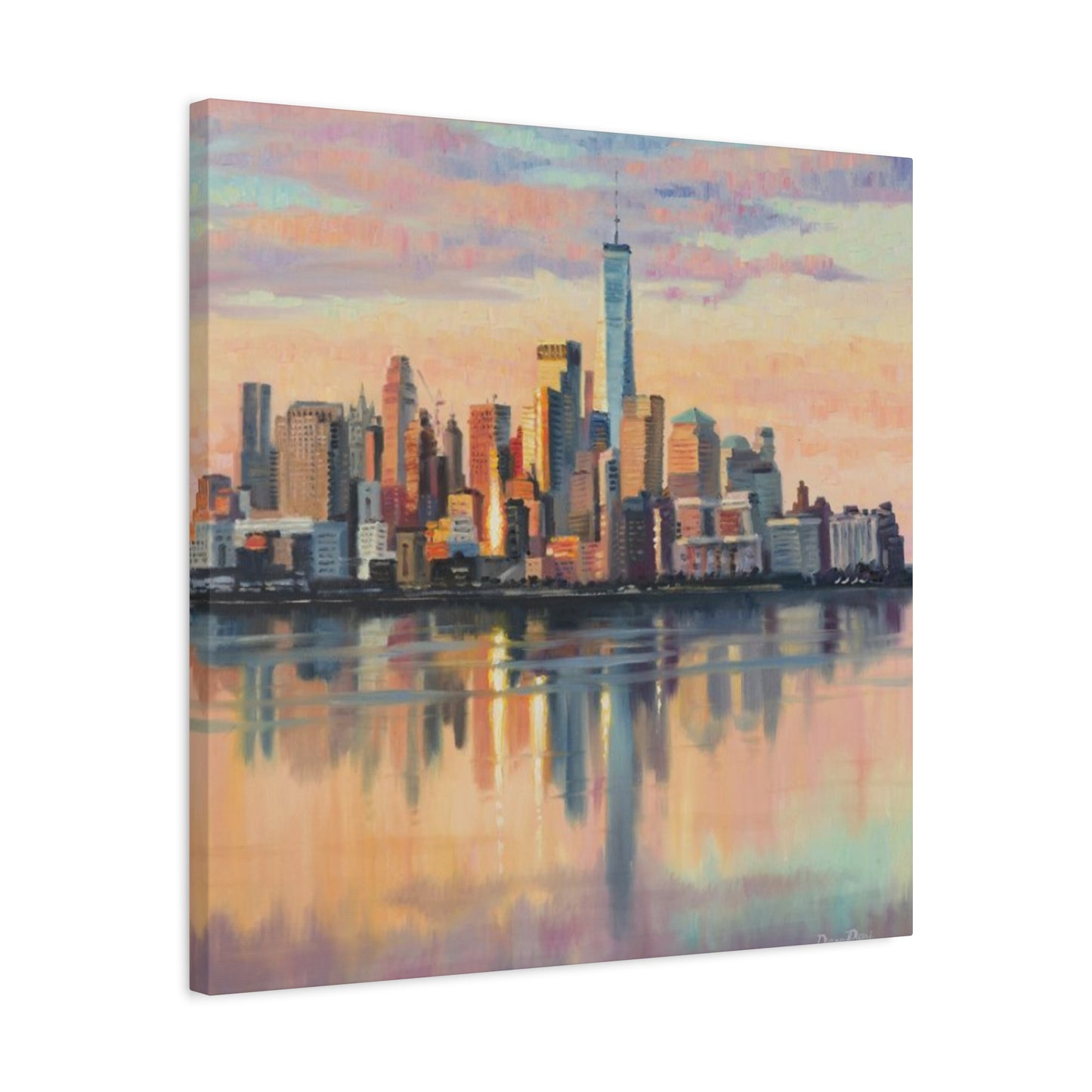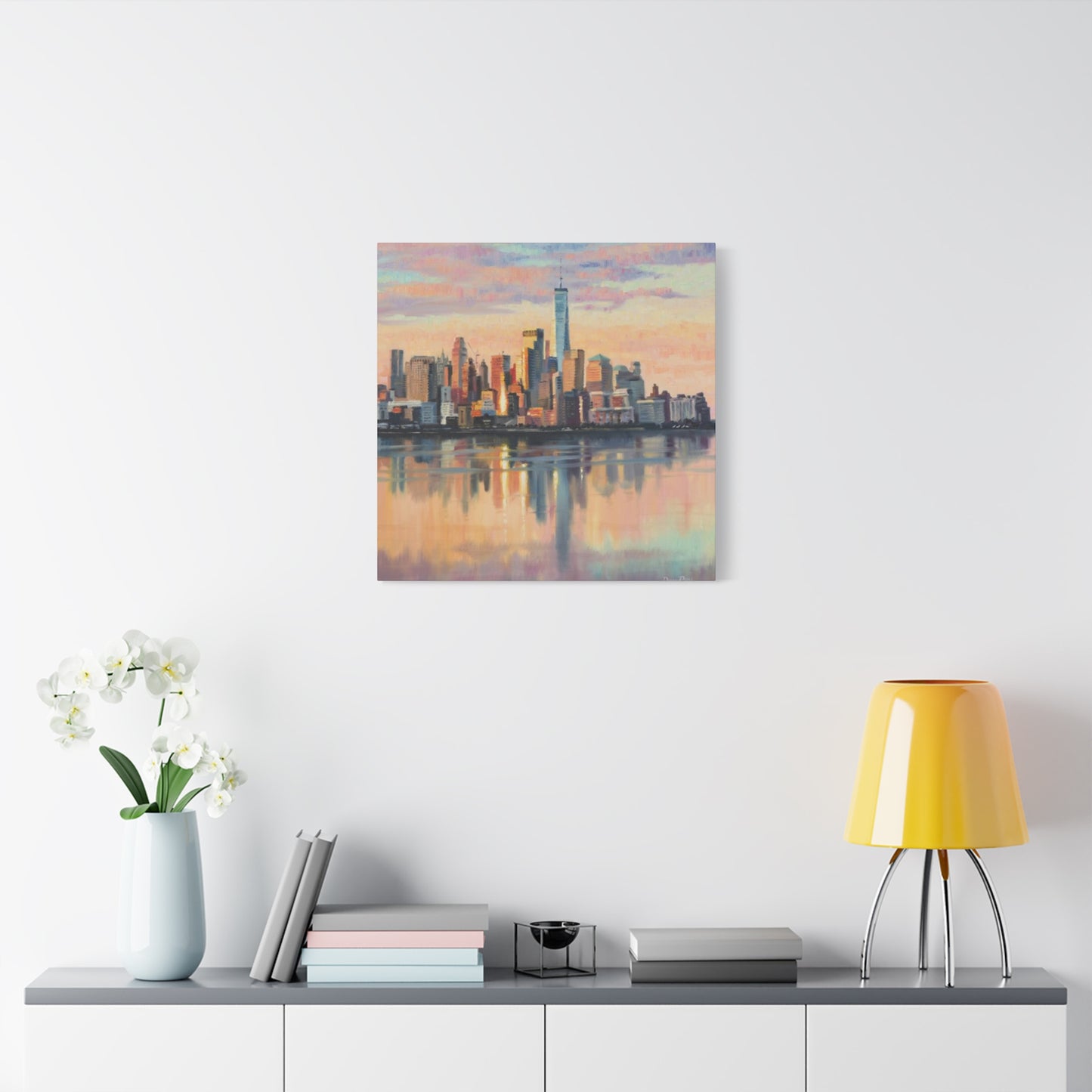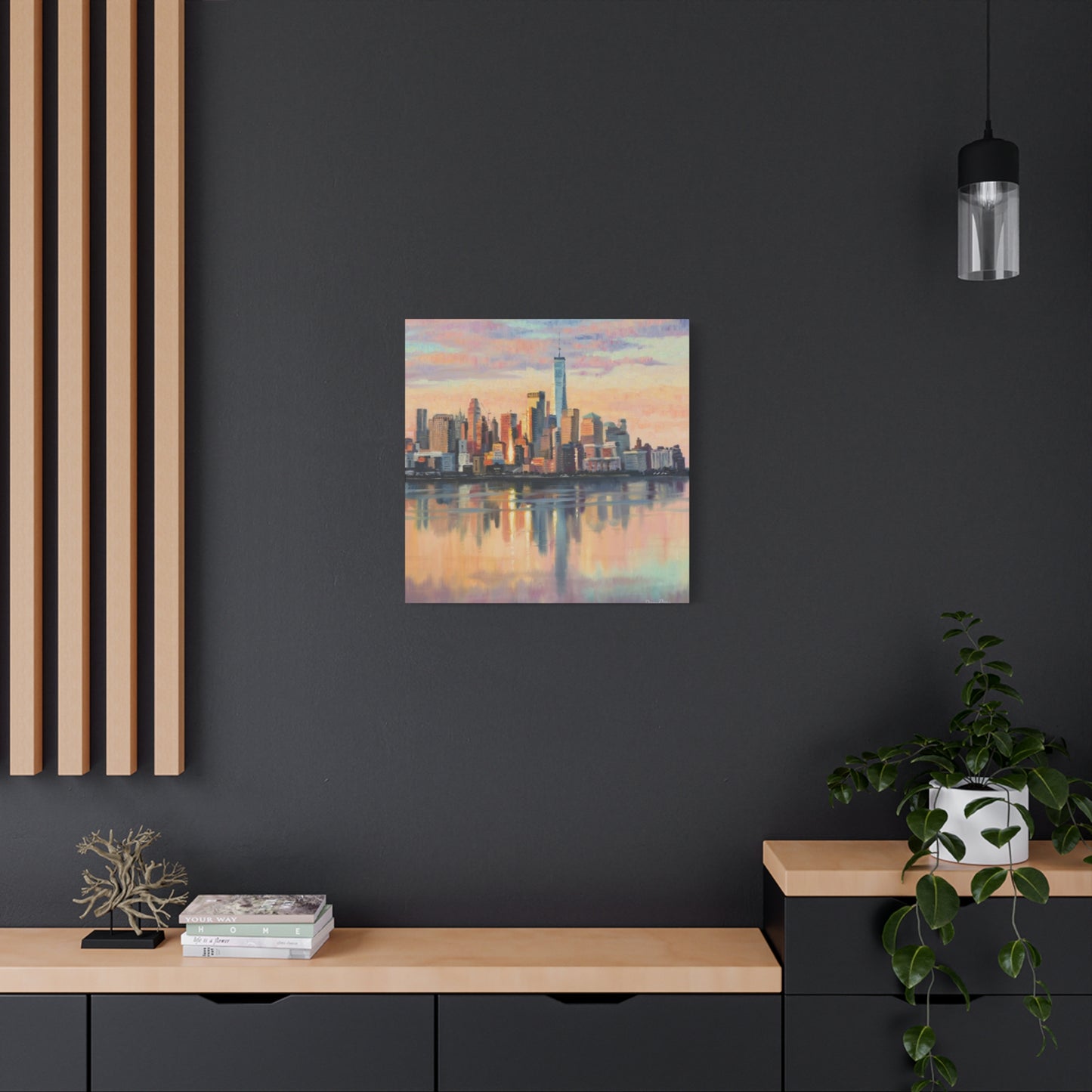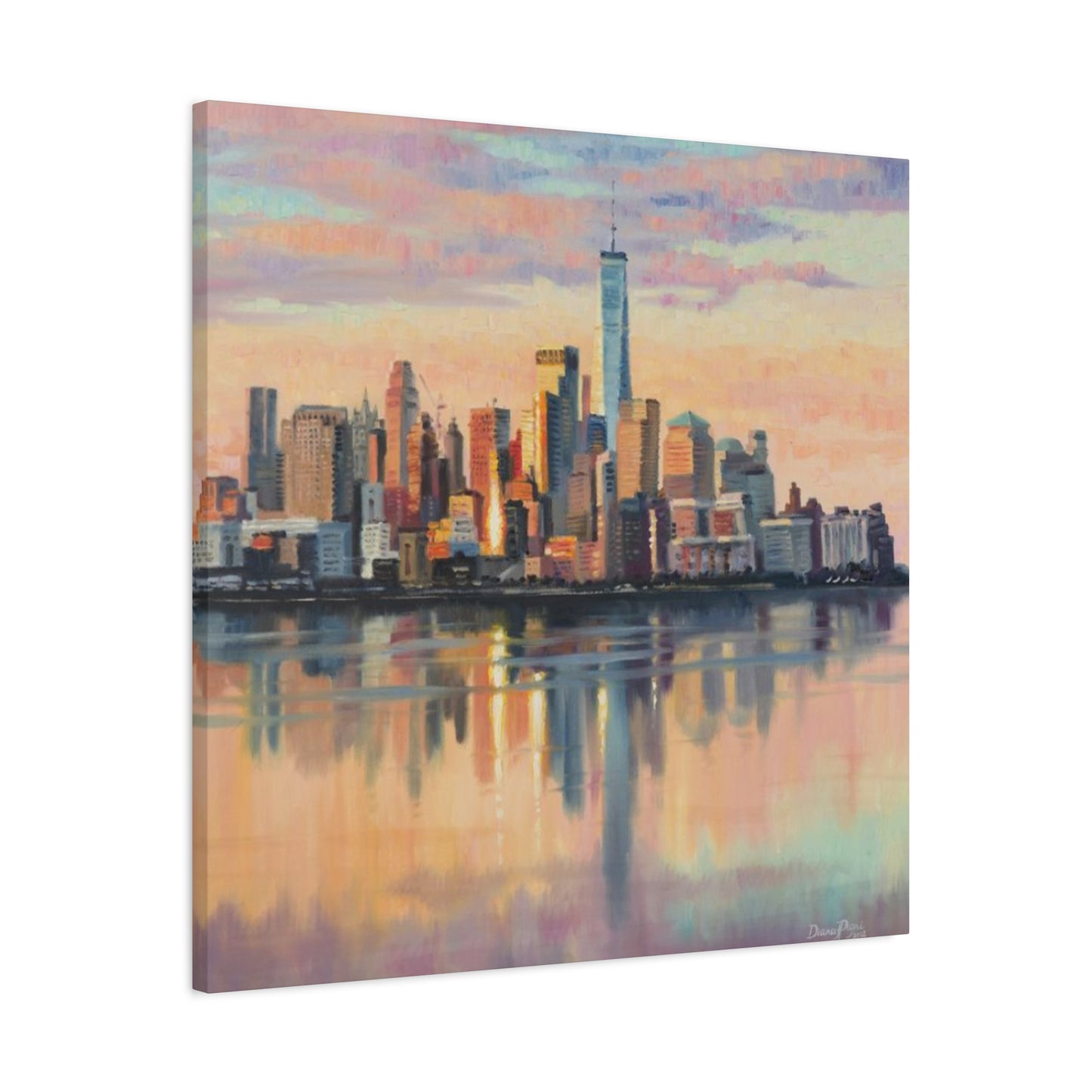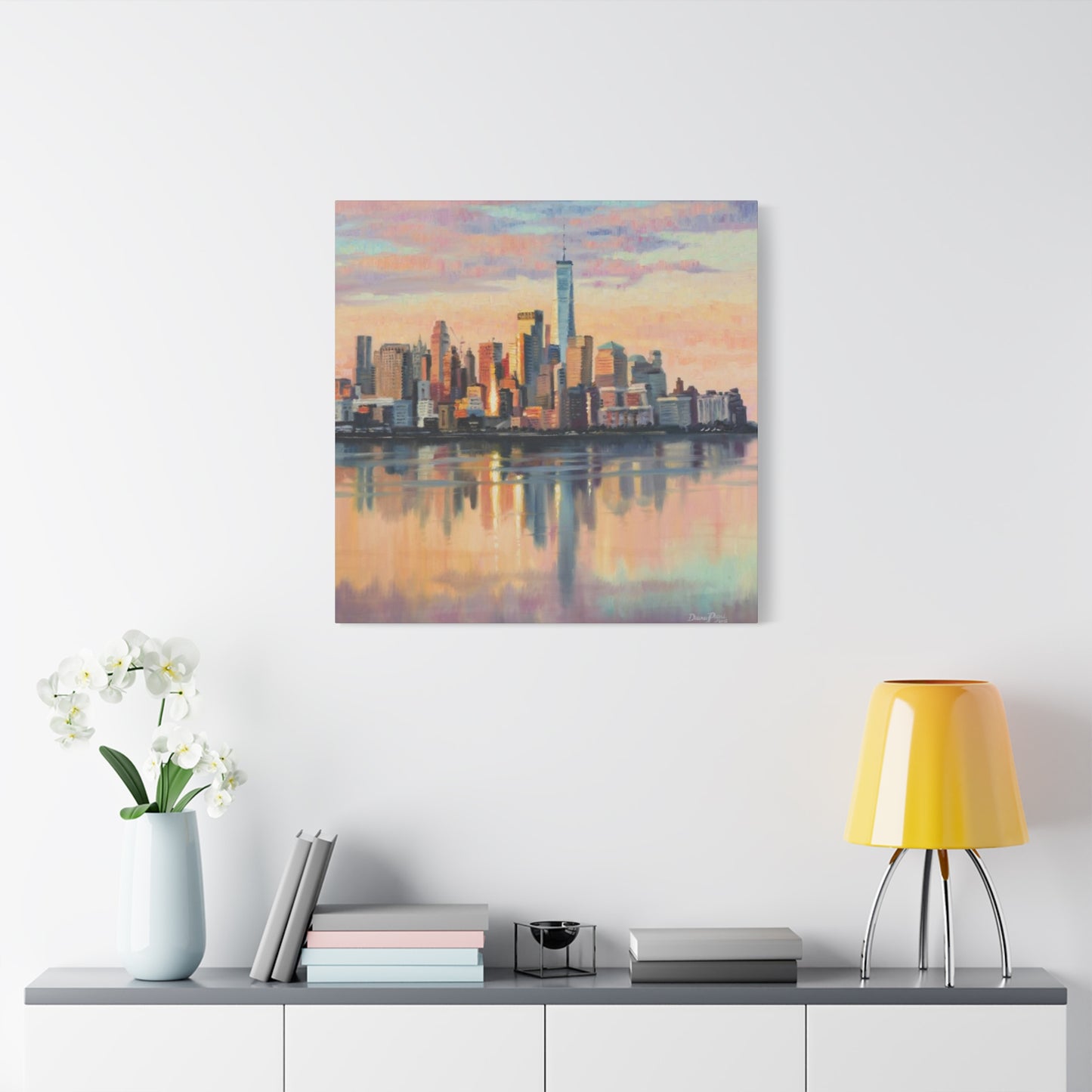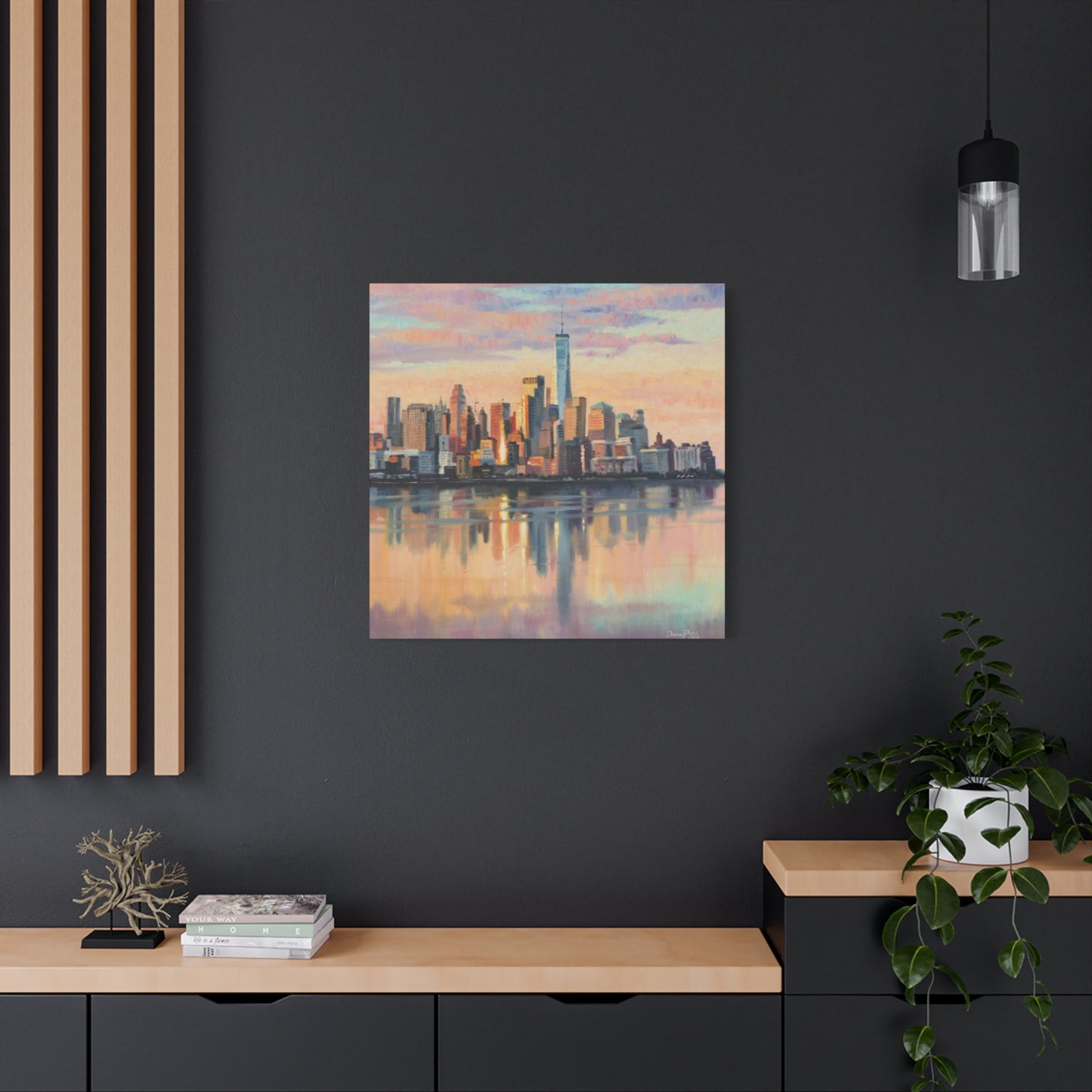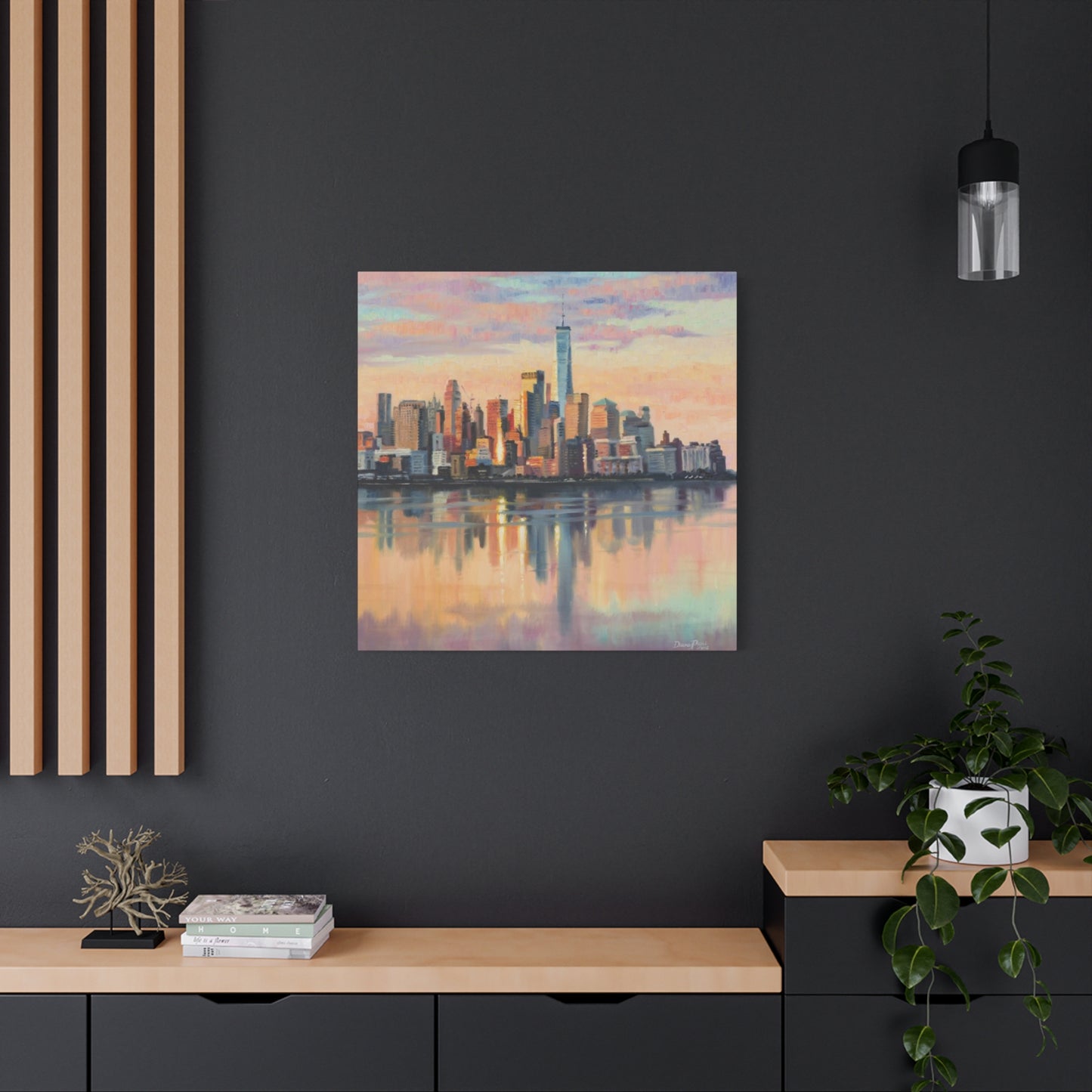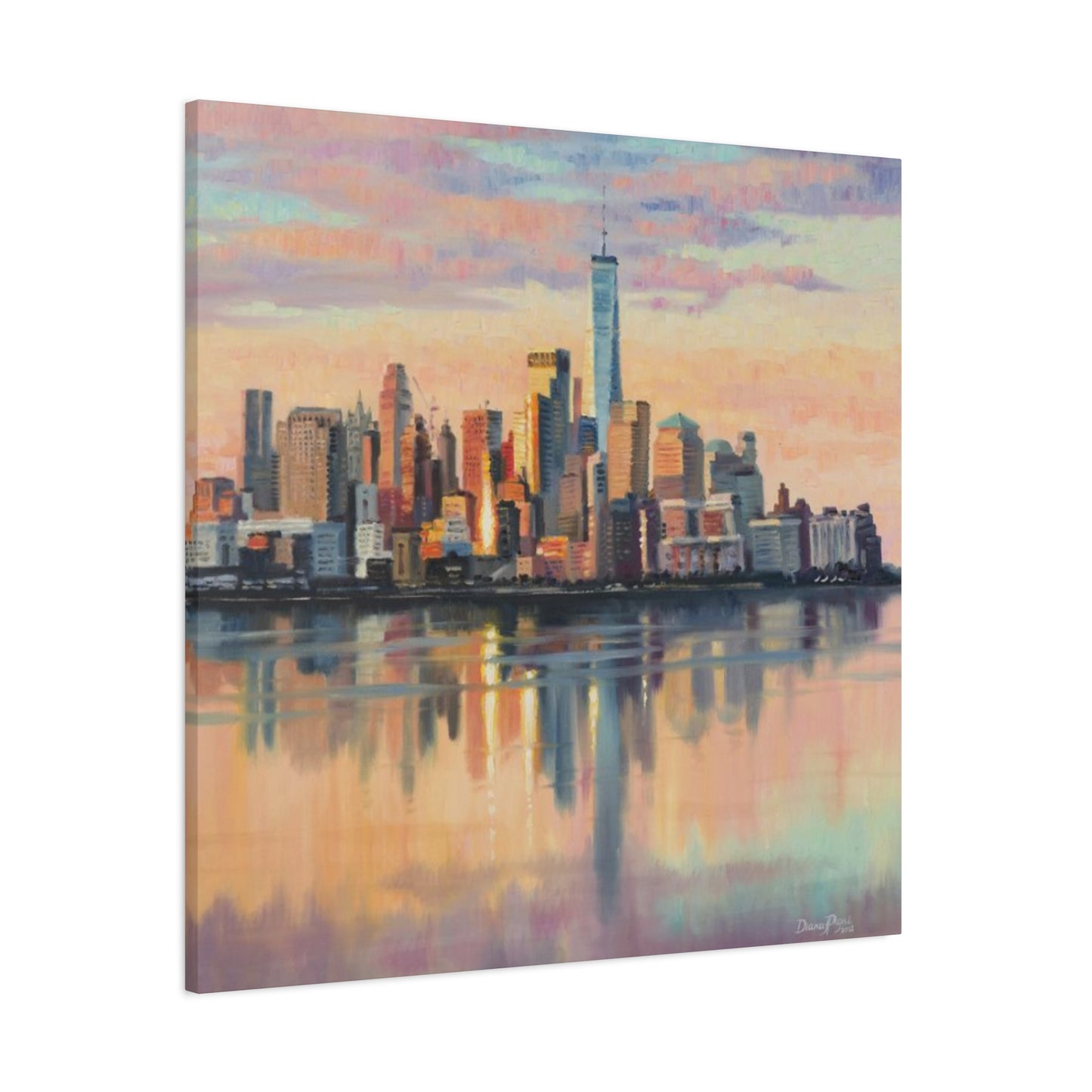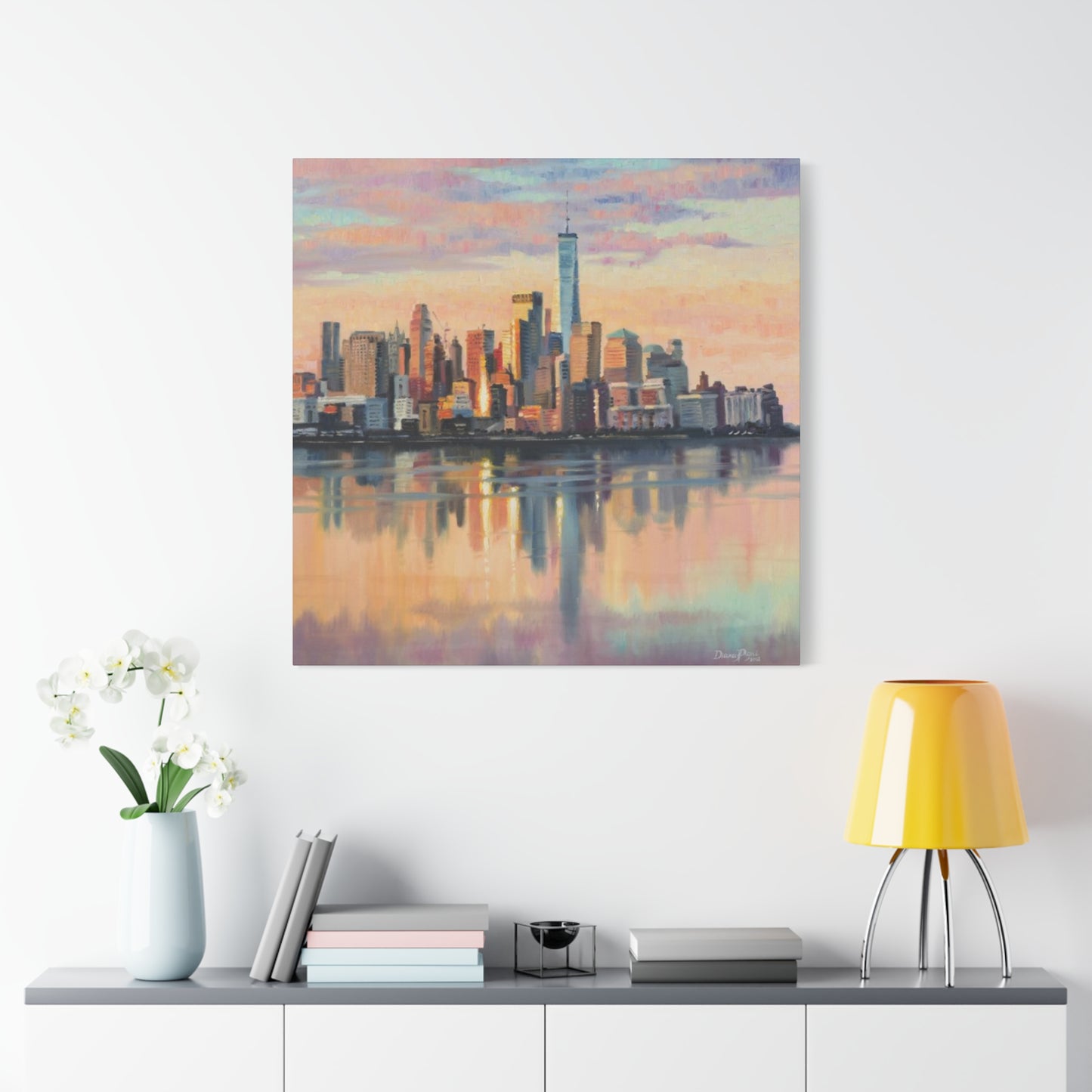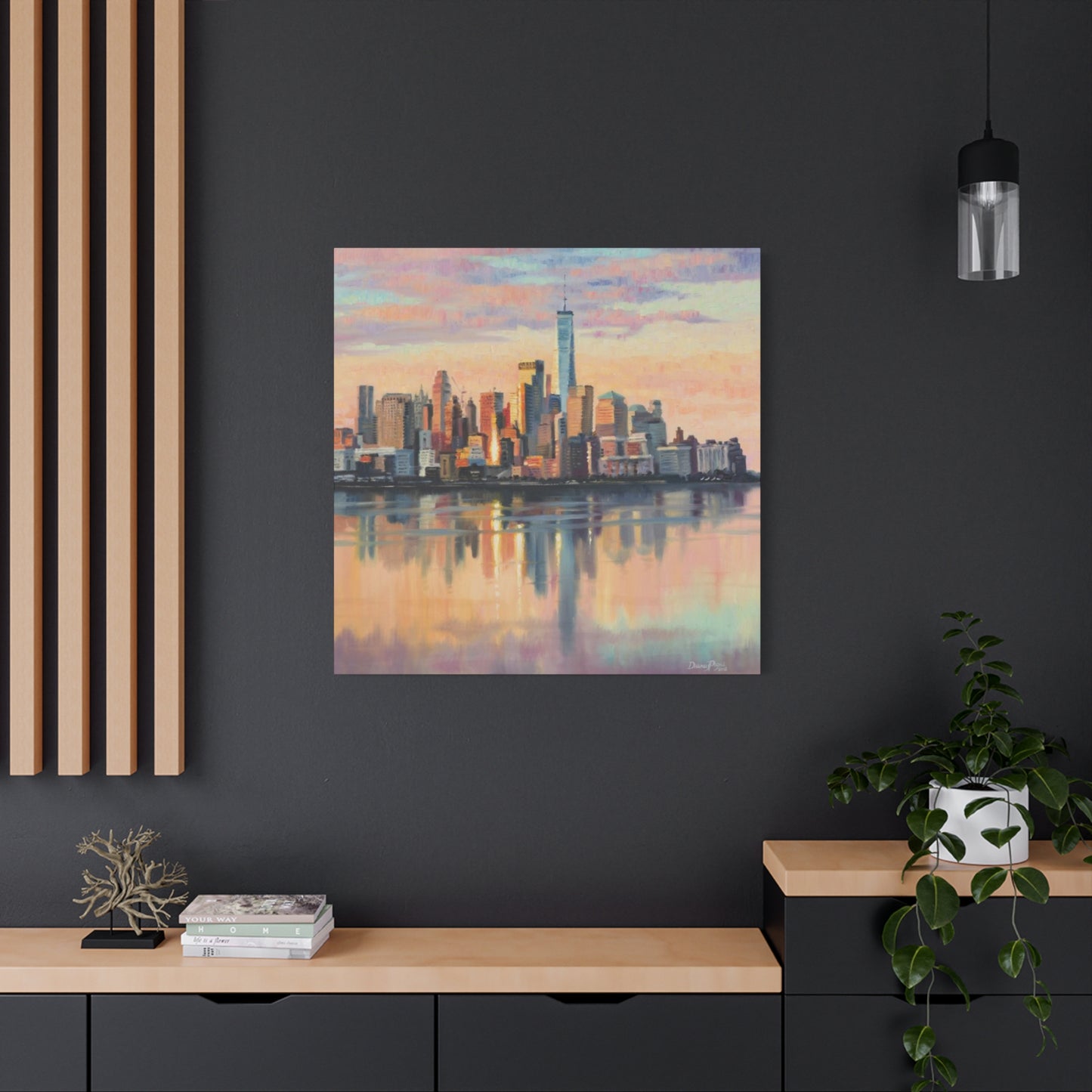How to Style Your Space With NYC Skyline Wall Art: From Minimalist Lofts to Classic Homes
The magnificent vista of New York City rising majestically from the waters has captivated artists, photographers, and design enthusiasts for generations. When you gaze upon the iconic buildings stretching toward the sky while framed by the endless expanse of the sea, you witness one of the most breathtaking urban landscapes on Earth. This extraordinary perspective has inspired countless pieces of wall art that bring the energy, sophistication, and timeless appeal of the metropolis into homes and offices worldwide. The combination of architectural grandeur with the natural beauty of coastal waters creates a visual narrative that speaks to both urbanites and nature lovers alike.
Wall art featuring this particular vantage point offers more than mere decoration. It represents a connection to one of the world's most influential cities, a symbol of ambition, achievement, and the enduring human spirit. Whether you experienced the city firsthand or admire it from afar, incorporating such artwork into your living spaces transforms ordinary walls into windows overlooking an extraordinary urban seascape. The interplay between man-made structures and natural elements creates a balanced aesthetic that works harmoniously with various interior design approaches.
The Timeless Appeal of Metropolitan Coastal Imagery
The allure of urban landscapes viewed from water has remained constant throughout artistic history. This particular perspective of the famous cityscape offers a unique combination of elements that few other views can match. The buildings appear both imposing and elegant, their reflections dancing on the water's surface while the sky provides an ever-changing backdrop. This trinity of architecture, water, and sky creates visual interest that never grows stale, regardless of how many times you view it.
Photographers and artists have explored this subject from countless angles, each bringing their own interpretation to the scene. Some capture the golden hour when the setting sun bathes the buildings in warm amber light, while others prefer the cool blues of twilight when windows begin to glow like scattered jewels. The morning hours offer yet another mood, with fresh light revealing crisp details and the promise of a new day. Each variation tells a different story while maintaining the fundamental appeal of this iconic vista.
The psychological impact of such imagery extends beyond simple visual pleasure. Research in environmental psychology suggests that viewing scenes combining urban and natural elements can reduce stress while maintaining the stimulating qualities that pure cityscapes provide. The water in these compositions introduces a calming element that balances the energetic presence of the buildings, creating an artwork that feels both invigorating and peaceful. This duality makes it suitable for various spaces, from bustling offices to tranquil bedrooms.
Historical Significance of Waterfront Urban Views
The relationship between this particular metropolis and its surrounding waters runs deep through centuries of history. The harbor served as the gateway for millions seeking new opportunities, and the waterfront districts became centers of commerce, culture, and innovation. Artists began documenting these views as early as the colonial period, though the skyline appeared vastly different then. As the city grew vertically during the twentieth century, the waterfront perspective became increasingly dramatic and compelling.
Photographic documentation of the evolving cityscape from water began in earnest during the early 1900s. These images captured not just buildings but the spirit of an era, the ambition of a growing nation, and the architectural innovation that defined American progress. Historic photographs from this perspective have become valuable cultural artifacts, offering glimpses into how the city transformed from a low-rise commercial center to a vertical metropolis that defied previous construction limitations.
The artistic interpretation of these views evolved alongside photographic documentation. Painters from various movements found inspiration in the contrast between natural and constructed environments. Impressionists captured the atmospheric effects of light on water and building facades, while modernists emphasized geometric forms and the verticality of the architecture. Contemporary artists continue this tradition, incorporating new techniques and perspectives while honoring the enduring appeal of this subject matter.
Architectural Elements That Define the Horizon
The distinctive silhouette that defines this famous vista results from over a century of architectural evolution. Each era contributed its own style and scale, creating a layered visual history that unfolds across the horizon. The earliest tall structures introduced the concept of vertical expansion, while art deco masterpieces from the 1920s and 1930s added ornamental crowns and setback designs that created the classic stepped profile many associate with classic American architecture.
Mid-century modernism brought a different aesthetic, with glass and steel towers emphasizing clean lines and reflective surfaces. These buildings introduced transparency to the skyline, allowing light to interact with structures in new ways. As construction techniques advanced, buildings grew taller and their forms became more varied. Some architects chose to create distinctive tops that would be recognizable from great distances, understanding that the skyline view was as important as street-level experience.
Contemporary additions to the cityscape have pushed boundaries even further, with supertall residential towers introducing slender profiles that seem to pierce the sky. These newest structures often feature innovative engineering solutions that allow them to reach unprecedented heights while maintaining stability against wind forces. The result is a constantly evolving skyline that manages to retain its essential character while embracing innovation and change.
The Role of Water in Urban Landscape Photography
Water serves multiple artistic functions in compositions featuring this metropolitan view. As a reflective surface, it doubles the visual information, creating mirror images that can be rendered clearly or abstractly depending on conditions and artistic intent. Calm water produces sharp reflections that create symmetrical compositions, while choppy conditions fragment and distort the mirrored image, adding movement and energy to static scenes.
The color of water varies dramatically based on time of day, weather conditions, and surrounding light sources. During blue hour, the water often takes on deep sapphire tones that contrast beautifully with illuminated buildings. Sunset conditions can turn the surface into liquid gold or flame, while overcast days produce muted grays and silvers that create moody, contemplative atmospheres. Each variation offers different emotional qualities and design possibilities for interior spaces.
Water also provides scale and context that help viewers understand the magnitude of the architecture. The expanse of liquid stretching from foreground to city base emphasizes the distance and the impressive size of the structures rising from the shore. This sense of scale contributes to the dramatic impact of such imagery, making even small prints feel grand and expansive. The horizontal emphasis of the water's surface also balances the vertical thrust of the buildings, creating compositional harmony.
Color Palettes and Their Psychological Effects
The chromatic range present in coastal urban imagery spans from cool blues and grays to warm oranges and golds, depending on lighting conditions and post-processing choices. Cool color schemes dominated by blues and silvers evoke feelings of calm, professionalism, and modernity. These palettes work exceptionally well in corporate environments, home offices, and contemporary living spaces where a sophisticated, uncluttered aesthetic is desired.
Warm color palettes featuring golden hour light or sunset conditions introduce feelings of warmth, comfort, and optimism. These tones complement traditional interiors, rustic designs, and spaces where a welcoming atmosphere is paramount. The warm glow of building lights against twilight skies offers a middle ground, combining the energy of warm tones with the serenity of evening blues.
Monochromatic treatments in black and white or sepia eliminate color considerations entirely, focusing attention on form, contrast, and composition. These timeless interpretations work with virtually any color scheme and tend to feel more formal and artistic than their colorful counterparts. The absence of color also emphasizes textures and patterns, from the ripples on water surfaces to the repetitive windows creating geometric patterns across building facades.
Selecting the Perfect Perspective and Composition
Viewing angles dramatically affect the character and impact of urban coastal imagery. Head-on perspectives that place the skyline parallel to the picture plane create stable, balanced compositions that emphasize the architectural ensemble as a unified entity. These straight-on views work well for wide-format pieces and provide clear recognition of the city's distinctive profile.
Angled approaches that view the cityscape from either side introduce diagonal lines and depth, creating more dynamic compositions with enhanced three-dimensionality. These perspectives often reveal multiple faces of buildings simultaneously and create leading lines that draw the eye through the composition. The sense of movement and dimensionality in angled views can make spaces feel more energetic and engaging.
Elevated viewpoints from bridges, watercraft, or distant shores provide context and scale by including more foreground elements. These compositions might incorporate boats, piers, or shoreline features that add layers of interest while establishing the viewer's position relative to the city. Lower angles, particularly those shot from deck level on watercraft, emphasize the towering quality of the architecture and can make the city feel more imposing and dramatic.
Weather Conditions and Atmospheric Effects
Meteorological conditions dramatically influence the mood and visual qualities of maritime urban scenes. Clear, sunny conditions produce crisp details, vibrant colors, and high contrast between shadows and highlights. These conditions are ideal for creating artwork with maximum clarity and a positive, energetic feeling. The sharpness of such images suits modern interiors where precision and boldness are valued.
Overcast or foggy conditions introduce atmospheric haze that softens details and reduces contrast. Buildings may appear as ghostly silhouettes emerging from mist, creating mysterious and contemplative moods. These conditions produce images with limited color palettes dominated by grays and muted tones, perfect for minimalist interiors or spaces requiring subtle, non-distracting artwork.
Dramatic weather including storm clouds, rain, or unusual light creates powerful imagery with strong emotional impact. The contrast between dark, threatening skies and the steadfast presence of the illuminated city speaks to themes of resilience and human achievement. Such images make bold statements and work well as focal points in rooms where dramatic impact is desired.
Seasonal Variations in Urban Waterfront Scenes
Each season brings distinct qualities to views of the famous metropolitan skyline. Winter offers perhaps the most dramatic transformations, with potential snow coverage creating white caps on buildings and ice forming along the water's edge. The lower angle of winter sunlight produces long shadows and warm color temperatures during brief afternoon hours, while longer nights mean extended periods of twilight blue light that makes illuminated buildings particularly striking.
Spring introduces fresh, clear light as humidity levels remain moderate and trees along the waterfront begin showing new growth. The quality of light during this season tends toward bright, cheerful characteristics with good visibility of distant details. Spring also brings variable weather that can produce dramatic cloud formations and rapidly changing conditions that create unique photographic opportunities.
Summer's haze and humidity often create atmospheric effects that soften distant details while the higher sun angle produces shorter shadows and more overhead lighting. Summer evenings offer extended golden hour periods and spectacular sunset displays as weather systems move through the region. The warm season also sees increased waterborne activity, with boats and ferries adding movement and human scale to compositions.
Autumn provides arguably the most photographically favorable conditions, with lower humidity producing exceptional clarity and visibility. The autumn light quality, particularly in early morning and late afternoon, creates rich, saturated colors with excellent contrast. This season also offers dramatic weather systems and spectacular cloud formations that enhance compositions without obscuring the skyline.
Print Technologies and Material Considerations
The medium through which urban seascape imagery is reproduced significantly impacts its final appearance and longevity. Traditional photographic prints produced through chemical processes offer exceptional tonal range and archival stability when properly processed and stored. These prints feature smooth gradations and can produce deep, rich blacks that enhance dramatic compositions, particularly those featuring night scenes or dark water.
Giclee printing using archival pigment inks on fine art papers or canvas has become increasingly popular for reproducing this type of imagery. This technology offers wide color gamut, excellent detail retention, and superior longevity when using quality materials. Fine art papers provide texture and depth that can enhance the artistic qualities of an image, while canvas offers a painting-like appearance that suits traditional and transitional interior styles.
Metal prints create a contemporary aesthetic by infusing dyes directly into specially coated aluminum panels. This process produces vibrant colors with exceptional clarity and creates a luminous quality particularly effective for daytime scenes featuring bright skies and reflective water. The smooth, frameless appearance of metal prints suits modern and industrial interior styles while offering practical benefits including durability and easy maintenance.
Acrylic face-mounting creates depth and dimension by sandwiching prints between clear acrylic and backing materials. This technique produces intense colors and creates a glossy, glass-like finish that enhances the water elements in maritime urban scenes. The substantial physical presence of face-mounted pieces makes them suitable for large-scale installations in contemporary settings where bold, luxurious artwork is appropriate.
Scale and Proportion in Interior Settings
Determining appropriate artwork size requires careful consideration of wall dimensions, viewing distance, and surrounding elements. Small to medium prints ranging from sixteen to thirty inches in width work well in intimate spaces including bedrooms, home offices, and narrow hallways. At these scales, viewers can appreciate fine details while the artwork remains proportional to the space without overwhelming it.
Large format pieces spanning four to six feet horizontally create dramatic focal points suitable for living rooms, conference rooms, and hotel lobbies. These substantial works command attention and establish the design direction for entire spaces. When featuring panoramic water views of the cityscape, such large formats allow viewers to experience the expansive quality of the scene, almost creating a window-like effect on the wall.
Extra-large installations exceeding six feet or spanning multiple panels work in grand spaces with high ceilings and significant wall expanses. Corporate lobbies, luxury residences, and hospitality venues often require artwork at this scale to maintain proper proportion. Multi-panel arrangements or triptychs can extend even further while creating visual interest through the separation between sections.
The viewing distance from artwork should approximately equal its diagonal dimension for optimal impact. Pieces intended for close viewing in hallways or above furniture should contain sufficient detail to reward close inspection, while artwork meant for appreciation across large rooms can sacrifice fine detail for bold impact and simplified compositions that read clearly from distance.
Framing Techniques for Urban Seascapes
Framing choices significantly influence how maritime city views integrate with interior spaces. Traditional wood frames in neutral tones or classic profiles suit images regardless of style, providing timeless presentation that won't conflict with evolving design trends. Darker frames tend to contain and focus attention on the image, while lighter frames create softer boundaries that blend more subtly with surrounding walls.
Contemporary metal frames in silver, black, or brushed finishes complement modern interpretations of the urban seascape theme. Thin profile frames maintain emphasis on the image rather than the frame itself, while slightly wider frames provide substantial presence without becoming ornate. Metal frames particularly suit images printed on metal or featuring contemporary photographic styles with high contrast and saturated colors.
Floating frames that create space between the artwork and frame edge add dimension and contemporary sophistication. This treatment works particularly well with canvas prints or thick photographic papers, creating shadow lines that enhance the artwork's three-dimensional presence. The floating effect draws attention to the artwork itself while providing a refined finishing treatment.
Frameless presentations including gallery wrapping around stretcher bars, standoff mounting from the wall, or edge-lit display create ultra-contemporary looks. These approaches work best with modern or minimalist interiors where the artwork becomes an integrated architectural element rather than a traditional decorated surface. Frameless options also maximize the visible image area, particularly important with panoramic coastal city views where the horizontal expanse is key to impact.
Color Coordination with Existing Interiors
Integrating urban waterfront imagery into established color schemes requires analyzing both dominant and accent colors in the artwork. Pieces featuring primarily cool tones coordinate naturally with interiors using blues, grays, silvers, and white. These combinations create cohesive, serene environments particularly effective in bedrooms, bathrooms, and professional settings where calm focus is desired.
Images dominated by warm sunset or golden hour light complement spaces featuring earth tones, warm woods, and colors in the orange, red, and yellow families. These combinations create inviting, comfortable atmospheres in living rooms, dining areas, and casual gathering spaces. The warm light reflecting off buildings and water adds energy without overwhelming more subdued interior palettes.
Neutral interiors benefit from artwork that introduces color interest without overwhelming the space. Coastal urban scenes offer flexibility here, as the range of available color interpretations means finding pieces that provide just the right amount of visual interest. Monochromatic treatments work beautifully in all-neutral spaces, adding sophistication and visual texture without introducing competing color elements.
Bold, colorful interiors can accommodate equally vibrant interpretations of the metropolitan waterfront. Sunset scenes with intense oranges and purples or digitally enhanced pieces with saturated colors can hold their own against strong wall colors and eclectic furnishing choices. The key is ensuring the artwork contains colors that echo or complement dominant interior hues, creating connections rather than conflicts.
Lighting Design for Maximum Impact
Proper illumination dramatically enhances the viewing experience and protects artwork from deterioration. Natural daylight provides the most accurate color rendering but should be filtered or controlled to prevent direct sun exposure that can fade prints over time. Positioning artwork perpendicular to windows rather than opposite them reduces glare while allowing ambient daylight to illuminate the surface during day hours.
Picture lights mounted directly above or below artwork provide focused illumination that highlights the piece after dark or in dimly lit spaces. These fixtures should use LED bulbs with high color rendering index ratings to accurately reproduce the colors in coastal urban photography. Adjustable fixtures allow fine-tuning of light direction to minimize glare from glazing materials while maximizing surface illumination.
Track lighting or recessed spotlights offer flexible lighting solutions that can illuminate artwork while serving general room lighting functions. These systems work particularly well in galleries, hallways, and commercial spaces where multiple artworks require illumination. Careful aiming prevents hot spots or uneven lighting that can detract from viewing experience.
Integrated lighting including backlit panels or edge-lit acrylic creates dramatic contemporary presentations where the artwork itself appears to glow. This approach works exceptionally well with nighttime scenes or images featuring illuminated buildings, as the backlit presentation enhances the luminous quality already present in the subject matter. Such installations require planning during artwork selection and wall preparation but create unforgettable visual impact.
Creating Gallery Walls with Metropolitan Themes
Grouping multiple pieces creates visual impact greater than individual artworks while allowing exploration of various aspects of the waterfront urban theme. Systematic arrangements using identical frame sizes and regular spacing produce formal, organized presentations suitable for traditional or symmetrical interior designs. Such arrangements work well in hallways, stairwells, and formal living areas where order and classical aesthetics dominate.
Salon-style arrangements mixing various sizes, orientations, and frame styles create more casual, collected-over-time appearances. This approach allows combining different views, times of day, and interpretations of the metropolitan waterfront theme while maintaining thematic unity. Salon walls work beautifully in eclectic interiors, creative studios, and residential spaces where personal expression outweighs formal design conventions.
Chronological arrangements showing the evolution of the skyline or progressing through times of day tell visual stories that engage viewers intellectually as well as aesthetically. These narrative approaches work particularly well in spaces where people spend extended time, as the story revealed through the arrangement rewards repeated viewing and contemplation.
Color-graduated arrangements organize pieces from cool to warm tones or light to dark values, creating visual flow that guides the eye through the collection. This sophisticated approach requires careful selection and planning but produces elegant results particularly effective in modern or contemporary settings where design consciousness is evident throughout the space.
Incorporating Urban Art into Various Interior Styles
Contemporary minimalist interiors benefit from single large-scale pieces or carefully edited small collections featuring clean compositions and limited color palettes. Black and white renditions or monochromatic blue-toned images complement the restrained aesthetic while providing visual interest without clutter. Simple, thin frames or frameless presentations maintain the unadorned approach characteristic of minimalist design philosophy.
Industrial spaces with exposed brick, concrete, or metal elements naturally accommodate urban subject matter, creating thematic connections between artwork and architectural features. Oversized metal prints or distressed canvas treatments enhance the raw, urban character of industrial interiors. Images emphasizing the architectural elements and structural aspects of the skyline resonate particularly well within industrial contexts.
Traditional interiors featuring classic furniture, rich woods, and formal arrangements can incorporate maritime urban views through appropriate framing and color choices. Warm-toned images presented in substantial wood frames with traditional profiles honor conventional design principles while introducing contemporary subject matter. The timeless quality of certain perspectives and treatments allows them to function as modern classics within traditional settings.
Transitional spaces blending traditional and contemporary elements find metropolitan waterfront artwork an ideal choice, as the subject matter bridges classical and modern sensibilities. Medium to large scale pieces in neutral tones with simple but substantial frames work across style boundaries, providing focal points that complement rather than dictate overall design direction.
The Investment Value of Quality Urban Photography
Original photographic prints produced in limited editions by established photographers represent not only decorative purchases but potential investments. As with any art market, values depend on the artist's reputation, the image's desirability, edition size, and overall market conditions. Signed, numbered prints from recognized urban landscape photographers have shown appreciating values over time, particularly for images capturing the city at historically significant moments.
Authentication and documentation become crucial when considering photography as investment. Certificates of authenticity, edition information, and provenance records establish legitimacy and facilitate future resale should that become desired. Purchasing directly from photographers or established galleries ensures proper documentation while supporting the artists who create these compelling images.
Proper care and preservation protect both the aesthetic and financial value of photographic artwork. Climate-controlled environments with stable temperature and humidity levels prevent deterioration of print materials and substrates. Protection from direct sunlight and environmental contaminants ensures colors remain true and materials don't degrade prematurely. Professional framing using archival materials creates protective barriers while allowing safe display.
The emotional and aesthetic value of artwork often exceeds any financial considerations for most collectors. The daily enjoyment of powerful imagery, the connection to places and experiences represented, and the role art plays in creating meaningful living environments justify investment regardless of monetary appreciation potential. Nevertheless, choosing quality artwork from respected sources ensures purchases retain value both personally and potentially financially.
Digital Versus Traditional Artistic Interpretations
Traditional artistic media including painting, drawing, and printmaking offer unique interpretations of the metropolitan waterfront that differ fundamentally from photographic approaches. Painters simplify and emphasize elements according to artistic vision, creating idealized or expressive versions of the scene. The visible brush strokes, texture of paint, and inherent variations of hand-created work provide qualities impossible to replicate photographically.
Photography captures optical reality with detail and accuracy that painting cannot match, documenting specific moments in time with phenomenal precision. The mechanical nature of the photographic process produces results that feel immediate and authentic, creating different connections with viewers than interpretive paintings. Photographic prints can reproduce subtle gradations and fine details that showcase both the camera's technical capabilities and the photographer's skill in capturing decisive moments.
Digital manipulation and enhancement blur boundaries between photographic documentation and artistic interpretation. Modern post-processing allows photographers to adjust colors, tones, and even structural elements to create images that diverge significantly from camera-captured reality. These hybrid approaches combine photographic accuracy in detail rendering with painterly freedom in color and atmosphere, producing works that occupy territory between traditional categories.
Mixed media approaches combine photographic elements with painting, drawing, or digital illustration, creating unique pieces that exploit strengths of multiple mediums. These experimental works push creative boundaries while maintaining the recognizable subject matter that makes urban waterfront imagery so appealing. For collectors seeking truly unique pieces, mixed media works offer exclusivity that pure photography cannot provide.
Seasonal Interior Refreshment Through Art Rotation
Changing displayed artwork seasonally refreshes interior environments without requiring furniture rearrangement or major design updates. Rotating between different interpretations of the waterfront theme allows exploring various moods while maintaining stylistic consistency. Summer months might feature bright, sunlit daytime views while winter calls for dramatic twilight scenes or images with cooler color palettes that echo seasonal conditions outside.
Artwork storage requires consideration to protect pieces during periods out of display. Climate-controlled areas away from temperature extremes, humidity fluctuations, and direct sunlight preserve print integrity and prevent damage. Wrapping prints in acid-free materials and storing them flat or vertically in protective sleeves prevents creasing and surface damage. Proper storage ensures rotated pieces remain in excellent condition for years of seasonal display cycles.
The psychological benefits of environmental variation extend to visual elements including artwork. Seasonal rotation prevents habituation, where familiar images fade into background awareness and cease providing active enjoyment. Fresh images recapture attention and renew appreciation for both the artwork and the spaces they inhabit. This practice also allows building broader collections over time without overwhelming available wall space.
Practical considerations including hanging hardware and wall arrangements should accommodate rotation without requiring new holes or extensive reinstallation with each change. Adjustable hanging systems, identical frame sizes across rotated pieces, or careful documentation of hanging positions simplify the rotation process and encourage regular seasonal updates.
Commercial Applications in Hospitality and Corporate Settings
Hotels, restaurants, and hospitality venues utilize urban waterfront imagery to establish sense of place and create memorable guest experiences. Lobbies and public spaces benefit from large-scale installations that make immediate impressions, communicating sophistication and connection to the destination. Guest rooms feature smaller pieces that provide visual interest without overwhelming intimate spaces, with many properties choosing site-specific imagery that reinforces the location's identity.
Corporate offices incorporate metropolitan seascapes to project professionalism, ambition, and forward-thinking values associated with major urban centers. Reception areas and conference rooms receive larger, more dramatic pieces that impress visitors and establish company identity. Individual offices and collaborative spaces feature more modest works that create pleasant environments supporting productivity and creativity.
Healthcare facilities increasingly recognize artwork's role in creating calming, positive environments that support healing and reduce anxiety. Coastal urban views offer the dual benefits of nature elements through water and sky combined with the optimistic, vital energy of city imagery. The balanced character of these compositions makes them suitable for waiting areas, patient rooms, and staff spaces throughout medical campuses.
Retail environments use artwork to enhance brand identity and create distinctive shopping experiences. Urban imagery suits contemporary fashion boutiques, upscale home furnishing stores, and lifestyle brands targeting sophisticated, urban-aware consumers. The artwork contributes to overall store atmosphere while supporting merchandising objectives through appropriate mood setting and visual interest.
Personal Connection and Nostalgic Resonance
For many individuals, images of the famous metropolis evoke powerful personal memories and emotional connections. Former residents maintain bonds with the city through artwork that brings its presence into current homes regardless of distance. These pieces serve as reminders of formative experiences, professional achievements, or simply periods of life forever associated with urban living.
Visitors who experienced the city during memorable trips preserve those experiences through artwork that recaptures the excitement and wonder of discovery. A view from a particular ferry crossing or waterfront location might commemorate a proposal, family vacation, or pivotal personal moment, making the specific image deeply meaningful beyond its objective aesthetic qualities.
Aspirational connections motivate others to display metropolitan imagery representing goals, dreams, or values rather than direct experience. The city symbolizes opportunity, achievement, and participation in contemporary culture for many who have never visited but feel connected to what it represents. Artwork becomes a visual affirmation of ambitions and a daily reminder of possibilities.
Generational connections pass through family photographs or artwork that capture the city during different eras. Grandparents share their experiences of mid-century urban life through vintage prints, while contemporary images document the city for future generations. These pieces become family heirlooms carrying stories and connections across time.
Environmental Considerations in Art Production
Sustainable art production practices increasingly influence consumer choices as environmental awareness grows. Photographers and producers using eco-friendly materials, non-toxic inks, and sustainably sourced substrates appeal to environmentally conscious collectors. Certifications indicating responsible forestry practices for wood products or recycled content in papers provide assurance that artwork aligns with environmental values.
Local production reduces transportation impacts and supports regional economies while often providing more direct artist relationships. Many urban photographers offer work through local galleries or studios where buyers can meet artists and see production facilities firsthand. This transparency builds trust while reducing the carbon footprint associated with international shipping.
Print-on-demand models minimize waste by producing artwork only when orders are received rather than maintaining inventory that may never sell. This approach reduces resource consumption and eliminates unsold inventory disposal issues. Digital technologies enable efficient small-run production that would have been economically impractical using traditional methods.
Longevity and durability represent perhaps the most significant environmental considerations, as artwork lasting decades or generations avoids repeated replacement and the associated resource consumption. Quality materials, archival processing, and proper care ensure pieces remain beautiful and intact through long service lives, ultimately proving more sustainable than cheaper options requiring frequent replacement.
The Technical Craft of Urban Photography
Creating exceptional images of the cityscape from water requires technical mastery beyond simply pointing cameras at attractive subjects. Photographers must understand exposure principles that balance bright skies, mid-toned buildings, and often darker water surfaces within single frames. Graduated neutral density filters help manage extreme dynamic range, preventing blown highlights or blocked shadows that compromise image quality.
Timing proves crucial, as optimal light conditions exist briefly during morning and evening hours. Professional photographers often scout locations repeatedly, noting how light changes through seasons and weather conditions, planning shoots around optimal conditions. Patience allows waiting for perfect moments when light, atmosphere, and often transient elements like clouds or water conditions align perfectly.
Equipment choices significantly impact results, with various combinations of cameras and lenses offering different advantages. Wide-angle lenses capture expansive panoramic views while telephoto lenses compress perspective, making distant buildings appear larger relative to foreground elements. Professional large-format cameras provide maximum detail and resolution for huge prints, while smaller formats offer mobility and spontaneity.
Post-processing transforms raw captures into finished artworks through careful adjustment of exposure, color balance, contrast, and selective enhancement of important elements. Professional photographers develop personal processing styles that become recognizable signatures while maintaining natural appearance and avoiding excessive manipulation that appears artificial. The goal remains presenting compelling visions of reality rather than creating fantasy images disconnected from actual experience.
Emerging Technologies and Future Directions
Drone photography opens new perspectives previously inaccessible or extremely expensive to achieve. These aerial platforms capture unique angles and heights that provide fresh interpretations of familiar subjects. As regulations evolve and technology improves, drone imagery continues expanding creative possibilities for urban landscape photography.
High dynamic range imaging combines multiple exposures to capture extreme brightness ranges exceeding traditional camera capabilities. This technology produces images with detail throughout shadows, midtones, and highlights, creating technically perfect representations of high-contrast scenes. HDR techniques particularly benefit architectural photography where maintaining detail across varied lighting conditions is essential.
Gigapixel imaging technology creates photographs containing billions of pixels, allowing extreme enlargements while maintaining extraordinary detail. These massive files enable huge prints suitable for architectural installations while providing zoom capabilities that reveal details invisible at normal viewing scales. The process requires specialized equipment and processing but produces unprecedented image quality.
Artificial intelligence and machine learning technologies increasingly assist photographers in image enhancement, subject recognition, and even creative suggestions. While controversial in art circles, these tools democratize advanced techniques previously requiring years of skill development. The debate continues regarding where assistance becomes intervention that compromises authenticity and personal artistic voice.
Cultural Symbolism and Iconographic Significance
The metropolitan skyline functions as globally recognized symbol representing concepts beyond its physical reality. It embodies American achievement, capitalist success, cultural melting pot dynamics, and the vertical city concept that influenced worldwide urban development. This symbolic weight adds depth to artwork featuring the cityscape, making it simultaneously specific and universal in its appeal.
Media representation through countless films, television shows, and publications has embedded the skyline in global consciousness. These frequent appearances create familiarity even among people who have never visited, making the image instantly recognizable and culturally loaded with associations formed through media exposure. This cultural saturation creates immediate recognition and shared reference points across diverse audiences.
Architectural historians view the evolving skyline as a three-dimensional timeline of design philosophy and technical capability. Each building represents specific historical moments and the ambitions of its era. Collectively, the architecture tells stories of economic boom and bust, stylistic movements, engineering advances, and society's relationship with height and density in urban environments.
For artists and critics, the subject offers endless interpretive possibilities exploring themes including humanity's relationship with nature, the sublime in architecture, modernism and progress, capitalism's visual manifestations, and the tension between individual structures and the collective whole. This thematic richness ensures the subject remains relevant across changing artistic movements and cultural contexts.
Psychological Space Enhancement Through Vista Artwork
Interior spaces lacking windows or natural views benefit particularly from landscape artwork that provides visual escape and spatial expansion. Coastal urban imagery creates psychological windows that relieve the confining feeling of enclosed rooms. The depth implied in distant skylines and expansive water triggers perceptual responses that make rooms feel larger and less claustrophobic than they physically are.
Biophilic design principles recognize humans' innate connection to natural environments and the psychological benefits of nature exposure. While urban skylines might seem contrary to these principles, the water and sky components satisfy biophilic needs while adding stimulating architectural elements. This combination provides balance between calming natural elements and energizing human-made forms.
Attention restoration theory suggests that certain visual experiences help restore mental resources depleted by sustained focus and cognitive effort. Views combining fascinating elements that capture attention effortlessly without demanding concentration provide this restoration. The interplay of buildings, water, and sky offers engaging visual complexity that relaxes rather than stresses cognitive systems.
Prospect-refuge theory in environmental psychology explains attraction to views providing both openness and security. Waterfront city views photographed from elevated or distant positions satisfy the prospect component by offering expansive sightlines, while the implied photographer's position provides the refuge element. This combination produces inherently satisfying compositions that fulfill deep psychological preferences.
Maintenance and Preservation of Fine Art Prints
Dusting artwork requires gentle approaches that avoid damaging print surfaces or glazing materials. Microfiber cloths or soft brush attachments on vacuum cleaners remove dust from frames and glazing without scratching. Prints behind glass need only occasional gentle cleaning with appropriate glass cleaners applied to cloths rather than sprayed directly, which could cause liquid to seep under glazing and damage prints.
Environmental controls prevent common deterioration issues including fading, discoloration, and structural damage. Maintaining relative humidity between forty and sixty percent prevents excessive moisture that encourages mold growth or extreme dryness that makes paper brittle. Temperature stability prevents expansion and contraction cycles that stress materials and mounting systems. Air quality considerations include avoiding areas with cooking fumes, cigarette smoke, or other atmospheric contaminants.
Periodic professional conservation inspections catch developing issues before they become serious problems. Conservators assess mounting integrity, check for signs of deterioration, and recommend preventive measures or repairs. For valuable pieces, establishing relationships with qualified conservators provides peace of mind and ensures proper care protocols.
Insurance documentation including photographs, purchase receipts, and appraisals protects investment value and facilitates claims should damage or loss occur. Regular updates reflecting current market values ensure adequate coverage, particularly for pieces that may appreciate significantly. Some valuable works merit specific scheduled coverage beyond general homeowner policies.
Conclusion
In conclusion, the NYC skyline wall art trend is much more than a decorative statement — it’s a celebration of culture, ambition, and timeless design. From minimalist lofts with sleek, modern aesthetics to classic homes with warm, traditional interiors, the iconic New York City skyline has proven its remarkable ability to adapt, inspire, and transform spaces. Whether displayed as a bold focal point or a subtle accent, NYC skyline wall art carries with it a powerful narrative that resonates with people across the world. It represents dreams, movement, and the endless possibilities that urban landscapes symbolize.
One of the key reasons for its popularity is its versatility. The clean lines, architectural details, and recognizable shapes of the New York skyline allow it to integrate seamlessly into various interior styles. In minimalist lofts, black-and-white skyline prints or simple line art bring balance and sophistication. They complement open spaces, neutral color palettes, and sleek furniture without overwhelming the design. Conversely, in classic homes where textures, patterns, and rich tones prevail, a detailed or painterly NYC skyline piece can serve as an elegant contrast — blending modern energy with timeless charm.
Additionally, the emotional and cultural significance of the New York skyline elevates it beyond simple decoration. For many, it’s a symbol of ambition, resilience, and hope. The sight of skyscrapers like the Empire State Building, the Chrysler Building, or One World Trade Center can evoke a sense of inspiration and connection, even for those who have never set foot in the city. When incorporated into personal living spaces, NYC skyline wall art becomes a daily reminder of big dreams, personal journeys, and the beauty of urban life.
Another important aspect of styling with skyline wall art is the choice of medium. Modern homeowners and designers have access to a variety of formats — from large-scale canvas prints and framed photographs to metal prints, acrylic panels, and minimalist line drawings. Each medium can create a distinct atmosphere. For example, a glossy metal print can amplify the modern and industrial character of a loft, while a sepia-toned photograph or hand-painted canvas might enhance the elegance of a more traditional home. The adaptability of the NYC skyline allows it to shift effortlessly between design eras and personal tastes.
Lighting also plays a critical role in showcasing skyline art effectively. Positioning the artwork under soft, warm lighting can create an inviting ambiance, while spotlighting or track lighting can draw attention to its intricate details and create a gallery-like effect. In minimalist spaces, a single illuminated skyline piece can stand as a statement of sophistication. In classic interiors, pairing the artwork with wall sconces or chandelier lighting adds depth and drama.
The placement and scale of the artwork significantly influence the overall feel of a room. Oversized skyline pieces are ideal for creating bold statements in living rooms, entryways, or above sofas. These large prints can anchor the room and give it a strong visual identity. Smaller, more delicate prints are perfect for bedrooms, reading nooks, or hallways, where they provide a touch of elegance without overpowering the space. Diptychs and triptychs — multi-panel arrangements — can add dimension and movement to the skyline imagery, enhancing its architectural beauty.
Furthermore, skyline art can work beautifully with a wide range of color schemes. Black-and-white prints offer timeless elegance and pair effortlessly with neutral palettes. Colorful skyline artwork, on the other hand, can inject vibrancy into a room, acting as a focal point that draws the eye. Earthy tones bring warmth, while cooler tones add serenity and balance. This flexibility gives homeowners the creative freedom to design their spaces in ways that reflect both their personal style and the unique spirit of New York City.
Importantly, NYC skyline wall art tells a story. It can represent a cherished memory, a future aspiration, or simply an admiration for the city’s energy and architecture. Whether it’s a photograph taken during a trip, a vintage-inspired print, or a modern digital illustration, each piece carries meaning. This personal connection transforms the art from mere decoration into a part of the home’s identity.
Looking ahead, the enduring appeal of New York City as a global icon ensures that its skyline will remain a beloved design element for years to come. As interior design trends continue to emphasize personality and storytelling, skyline wall art will continue to thrive. It offers a balance between modern urban sophistication and emotional resonance, making it suitable for spaces of all kinds.
Ultimately, styling your space with NYC skyline wall art is about more than choosing a pretty picture. It’s about creating an atmosphere — one that reflects ambition, individuality, and a connection to something bigger. Whether you live in a sleek city loft or a cozy suburban home, this art form can bridge different design styles and eras, infusing your space with timeless elegance and metropolitan charm. By carefully selecting the right piece, placement, and complementary elements, you can transform any room into a space that not only looks beautiful but also tells a meaningful story.

















